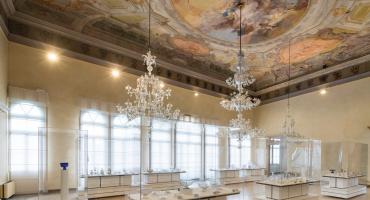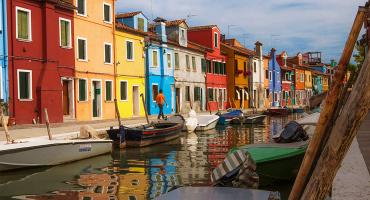The Venetian artisan artistic activity is identified by glass manufacturing and has got a thousand years old history, having reached the lagoon even before the Roman settlement and then getting developed through frequent contacts of Byzantine masters of glass-making at the time of the Fourth crusade.
In 13th century the art of “fioleri” (from fiole: phials or bottles) together with mosaics and blown glass becomes enormously developed and acquires such great importance for the city economy that it gets subjected to the Court of Justice which safeguards its activity.
In 1291, by order of the Great Council, to protect the city from the danger of fires originating from the use of furnaces, all the glass-making activity gets moved to Murano. Only “verixelli”, or rather small ovens, get authorised to remain, as long as they are at a certain distance from the houses.
From Murano furnaces there were produced articles of any kind, extremely refined and most appreciated all over Europe and so beautiful to be immortalized in the paintings of the great Venetian painters.
Angelo Barovier, belonged to one of the most historic families of the island and in mid 15th century made a thorough technological revolution in the glass manufacturing that will lead to an exceptional development in the subsequent centuries: he created a glass purer than anything similar to rock crystal. The Venetian art of glass-making met with its maximum splendour in 16th century, the masters of glass-making were perfecting vitreous materials and elaborating such particular manual techniques so that these were subjected to a downright activity of espionage and despite undertaken efforts to prevent the leakage of manufacturing “secrets”, artisans of the sector got settled in various European countries installing furnaces for production of glass objects.
The rivalry put the Venetian activity in crisis that started its decline with the end of the Republic and only in 19th century there were the first signs of recovery with the institution, in 1861, of “Glass Museum” and an enclosed school of drawing in Murano.
Antonio Salviati, another important name of the Venetian glass, created a laboratory of mosaics which embellished splendid buildings worldwide. Glass technician V. Moretti managed to reproduce in 1871, almost after one millennium, the “Roman murrine” which from then on started being part of the artistic repertoire of Murano. The glass art reached a high level of perfection in 19th century and still today Venice bases its economy on the production of magnificent glass objects thanks to the original design and refined implementation of glass-making masters of the great Murano companies: Barovier & Toso, Nason & Moretti, Seguso, Salviati, Venini and many others.
Venice continues to produce also magnificent glass beads which are, after a period of oblivion, having a particular emphasis in the productive and commercial structure of the city… Many shops scattered in all areas satisfy both the touristic request and the one of the great designers that have adopted glass beads in their fashion creations.
The history of glass beads is very interesting – they were created from the need to imitate the rosary beads called “paternoster beads” but also from the necessity to emulate precious stones that all the men had always desired to have to adorn themselves.
On that account, the legend tells that Marco Polo, returning to the city from his travels in the East, said how those people particularly loved beads and suggested to two resourceful glass-makers to reproduce them in glass.
It started like this, as testifies the reappearance of perforated pipe in 14th century, necessary for their production, an intense activity of imitation of corals, shells and precious stones. In a short time the glass beads had become very sought after in various markets and represented goods to be exchanged with other products, used even by Christopher Columbus as a gift to the natives.
There were two types of manufacturing using a narrow glass pipe (solid or with an internal opening): the one blown using flames (“with lamp”) by artisans actually called “lamp-worked” and the other one carried out with an instrument similar to a skewer (“on the spit”) therefore the beads got warmed in a moderately heated oven to round them up into desired shape.
Amongst the biggest ones (about 1cm) and elaborated one by one, hand modelled and decorated, we find today: lamp-worked beads, rose-cut beads, rosary beads, blown-glass beads. Amongst the smallest ones and of identical dimensions obtained by cutting of a long perforated pipe are the marguerites.
Even murrine, tiny glass miniatures, floral or geometric, represent one of the most interesting and happy Venetian specialisations precious for their design and colour.
In imitation of mosaic the glass-makers started this work in the second half of 19th century reapplying an ancient technique that imitated certain production of Roman vases obtained by a stone called “murrha”. It starts by working in a consequent phase series with “glass pipe”, constituted of various concentric layers which give, in section, the star motif.
The spreading and knowledge of splendid manufactured articles was obtained thanks to the Expositions of Art biennale but above all to manifestation of Ca’ Pesaro, where in the first years of 20th century artists like Vittorio Zecchin, Giuseppe Barovier and Brothers Toso brought the art of Murano glass to the international scene in that style, well-known in Europe as Art Nouveau.
The visit to Glass Museum of Murano results to be interesting and after an masterly restoration, it is possible to appreciate it following the history of glass from its origins to the present day, as per the adopted layout of chronological and stylistic subdivisions that allow pleasant and better understanding.



